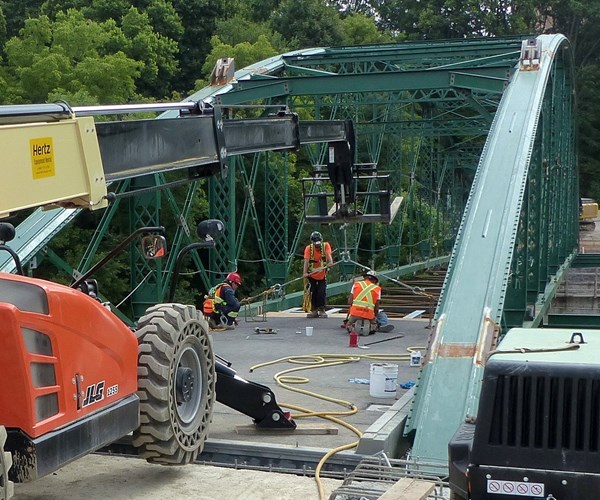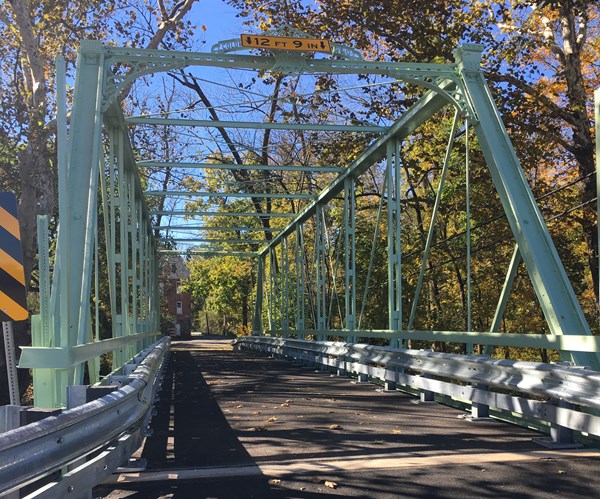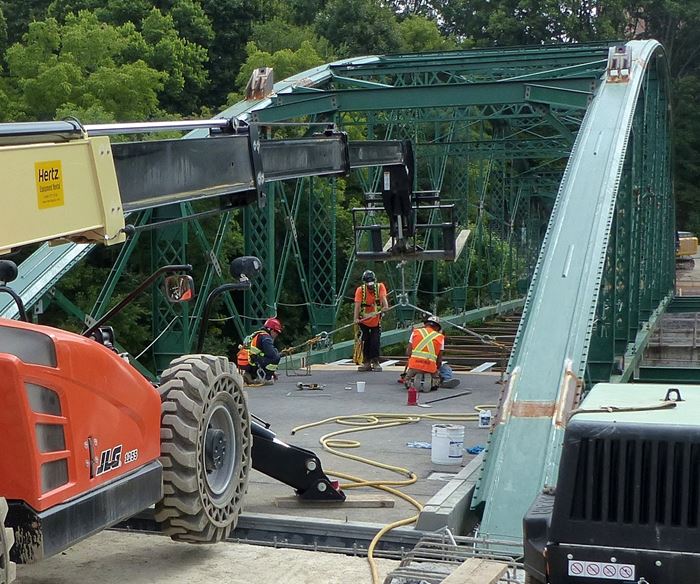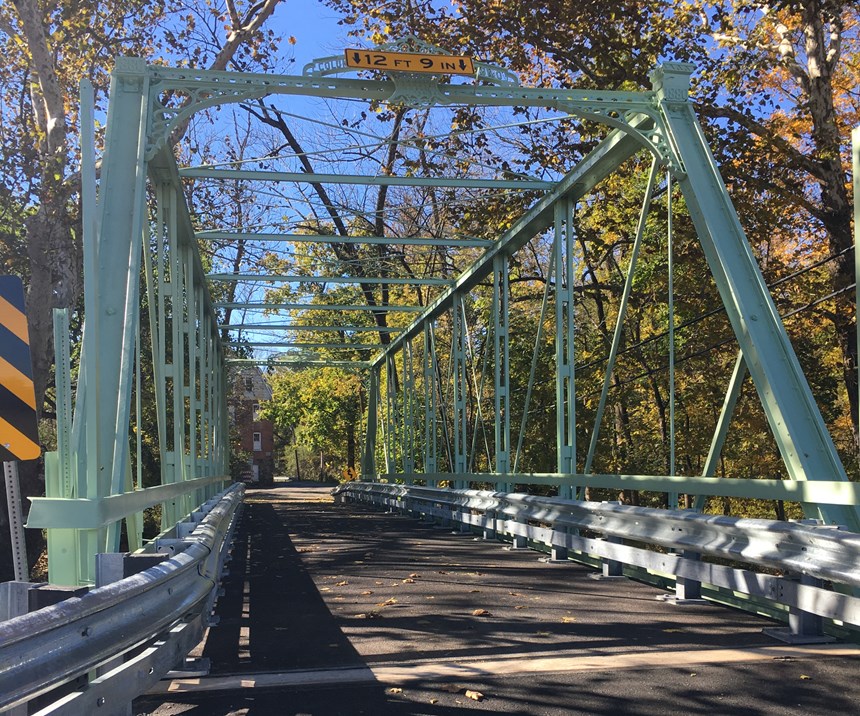FRP panels used in two bridge renovations
Composite Advantage announced the completion of two new FRP bridge projects employing the its FiberSPAN fiber reinforced plastic composite deck material.
Composite Advantage (Dayton, OH, US) recently announced the completion of two new FRP bridge projects employing the company’s FiberSPAN FRP composite deck. The supplier has been developing lightweight, high-strength, cost-effective FRP products for structurally demanding applications and corrosive environments since 2005.

Blackfriars Bridge gets new FRP deck. (Source | Composites Advantage)
Blackfriars Bridge (London, Ontario)
In October, Composite Advantage announced that a 143-year-old wrought iron bowstring arch-truss bridge in London, Ontario was given a new deck. In 2017, the City of London, Ontario launched a $7.9 million project to remove, dismantle and rehabilitate Blackfriars Bridge – Ontario’s oldest working crossing. Concrete combined with current traffic loads proved too heavy for the historic structure. London-based Dillon Consulting (London, Ontario, Canada) and the City of London selected Composite Advantage’s fiber reinforced polymer (FRP) FiberSPAN deck following research and study of the product’s performance on two Ottawa vehicle bridges.
“FRP panels are 80% lighter than reinforced concrete panels,” says Composite Advantage President Scott Reeve. “The goal was to preserve as many of the original components as possible such as the structure’s arches, lattice work and pedestrian railing. The design flexibility of FRP allowed us to mesh advanced composite material with Blackfriar’s original components to retain the beauty of the architecture while giving it long-lasting performance.”
Design requirements included a design vehicle loading of 75% of CL3-625-ONT with a 1.3 dynamic load allowance and a 0.9 environmental durability factor. Allowable stress design (ASD) standards and limit states design (LSD) determined safety factors which were compared to design strain requirements. Traditional beam bending equations were used to analyze FiberSPAN deck panels constructed as a series of closely spaced I-beams. Panels met an L/500 deflection. Bending strain/shear strain was less than 20% under the service load plus dead load. Minimum fatigue life was rated at 2,000,000 cycles. Panels were designed to a temperature differential of 60°C. The design allows the bridge deck to move independently of steel beams in the longitudinal direction.
The 221.5-ft long FRP deck was installed on Blackfriars’ rehabilitated steel truss. Direct bolting of the 17.5 ft-wide panels was designed to handle braking loads while connection clips resist uplift and lateral movement of the bridge. Panel widths ranged from 7 inches to 9 inches thick with a molded in crown. Curbs, integrally molded into the FRP deck, were covered with 3/8-inch thick 304 stainless steel plates to protect from wheel impacts and snow plows. The FRP deck was given a dark aluminum oxide wear surface. The large prefabricated FRP panels eliminate the labor and hours associated with assembling multiple pieces or pouring concrete.

Peevy Road Bridge (Montgomery County, PA, US) gets FRP deck. (Source | Composites Advantage)
Peevy Road Bridge (Montgomery County, PA, US)
In November, Composite Advantage announced the reopening of historic County Bridge 231, also known as the Peevy Road Bridge in Montgomery County, PA, US. The structure was built in 1880 by Columbia Bridge Works (Dayton, OH, US). David Morrison’s prescient Pratt truss design employed pairs of small rolled I-beams held together by square blocks placed between the sets. In 2016, due to rusted steel, it was determined the bridge required a lightweight, high-strength fix.
The design flexibility of FiberSPAN allowed Composite Advantage to accommodate a depth limit dictated by approach roads, match grating depth, meet load requirements and provide a solid surface deck to protect steel undergirding. FRP panels were 15 ft wide by 11 ft long with deck thicknesses that varied from 5 inches to 6 3/8 inches. The FRP vehicle deck was built with a flat bottom and a 1.5% crown. A 3/8-inch aluminum oxide overlay was applied to the deck panels to provide a safe driving surface capable of supporting large snow plows. Deck connections consisted of 304 stainless steel clips for long term durability. Panel to panel joints were ship lapped, bolted and bonded with MMA adhesive.
The FRP vehicle deck was built to meet AASHTO HS-20 vehicle plus impact loading with a 0.9 environmental durability factor; L/400 maximum deflection, a service load plus dead load with a bending strain/shear strain maximum of 20%t and a dead load with bending strain/shear strain maximum of 10%. Panels were designed for a 100°F temperature variation and a minimum fatigue life of 2,000,000 cycles. The panels meet class 2 fire resistance per ASTM 3-84.
Peevy Road Bridge re-opened to traffic in October. Composite Advantage estimates FRP will protect the bridge’s steel skeleton and extend the structure’s life by another 100 years.
Related Content
SGL Carbon carbon fiber enables German road bridge milestone
A 64-meter road bridge installed with carbon fiber reinforcement is said to feature a first in modern European bridge construction, in addition to reducing construction costs and CO2 emissions.
Read MoreComposites end markets: Infrastructure and construction (2024)
Composites are increasingly used in applications like building facades, bridges, utility poles, wastewater treatment pipes, repair solutions and more.
Read MoreCCG meets customer demand with StormStrong utility pole lineup
Additional diameters build on the portfolio of resilient FRP pole structures for distribution and light pole customers.
Read MoreRecycling end-of-life composite parts: New methods, markets
From infrastructure solutions to consumer products, Polish recycler Anmet and Netherlands-based researchers are developing new methods for repurposing wind turbine blades and other composite parts.
Read MoreRead Next
“Structured air” TPS safeguards composite structures
Powered by an 85% air/15% pure polyimide aerogel, Blueshift’s novel material system protects structures during transient thermal events from -200°C to beyond 2400°C for rockets, battery boxes and more.
Read MoreDeveloping bonded composite repair for ships, offshore units
Bureau Veritas and industry partners issue guidelines and pave the way for certification via StrengthBond Offshore project.
Read MoreVIDEO: High-volume processing for fiberglass components
Cannon Ergos, a company specializing in high-ton presses and equipment for composites fabrication and plastics processing, displayed automotive and industrial components at CAMX 2024.
Read More
























